Stinging nettles are one of the finest wild greens you can use to make soup, and there's plenty of recipes out there. Some are good, some are ok but this is my favorite nettle soup recipe of all time.
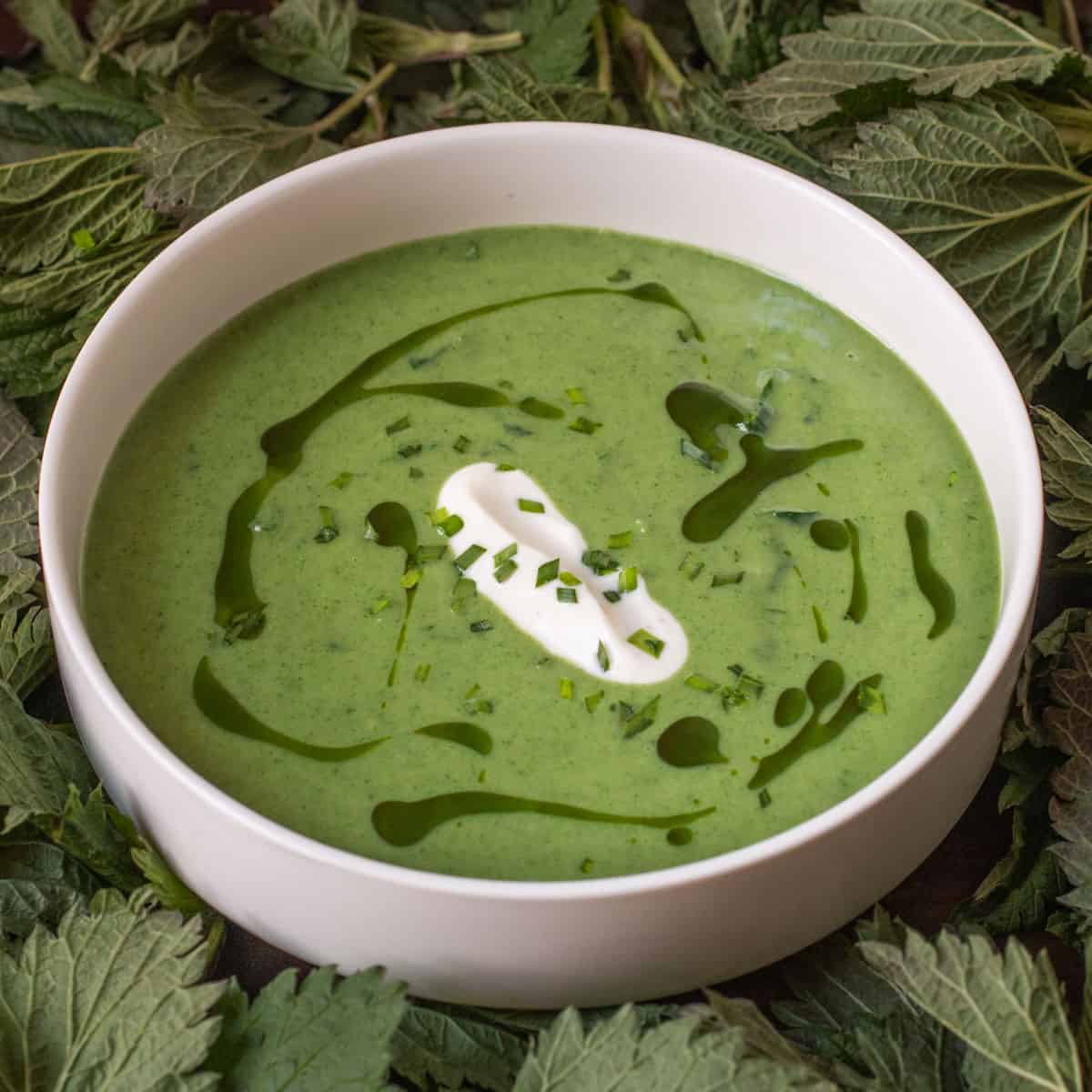
I originally developed the recipe for a dinner I billed at $1000 per person for a group of CEOs. To my surprise, instead of the truffles and foie gras, everyone agreed it was the highlight of the meal.
Why this recipe works
Most nettle soup recipes call for blanching and shocking the nettles in ice water, then squeezing them dry. Blanching, while necessary for some things, isn't necessary for many greens, and the water leeches out flavor from them.
Steaming the nettles quickly, then allowing them to cool, spread out on a tray, will have a stronger flavor as nothing is lost to water. That said, you can get a great result from either blanched or steamed nettles here.
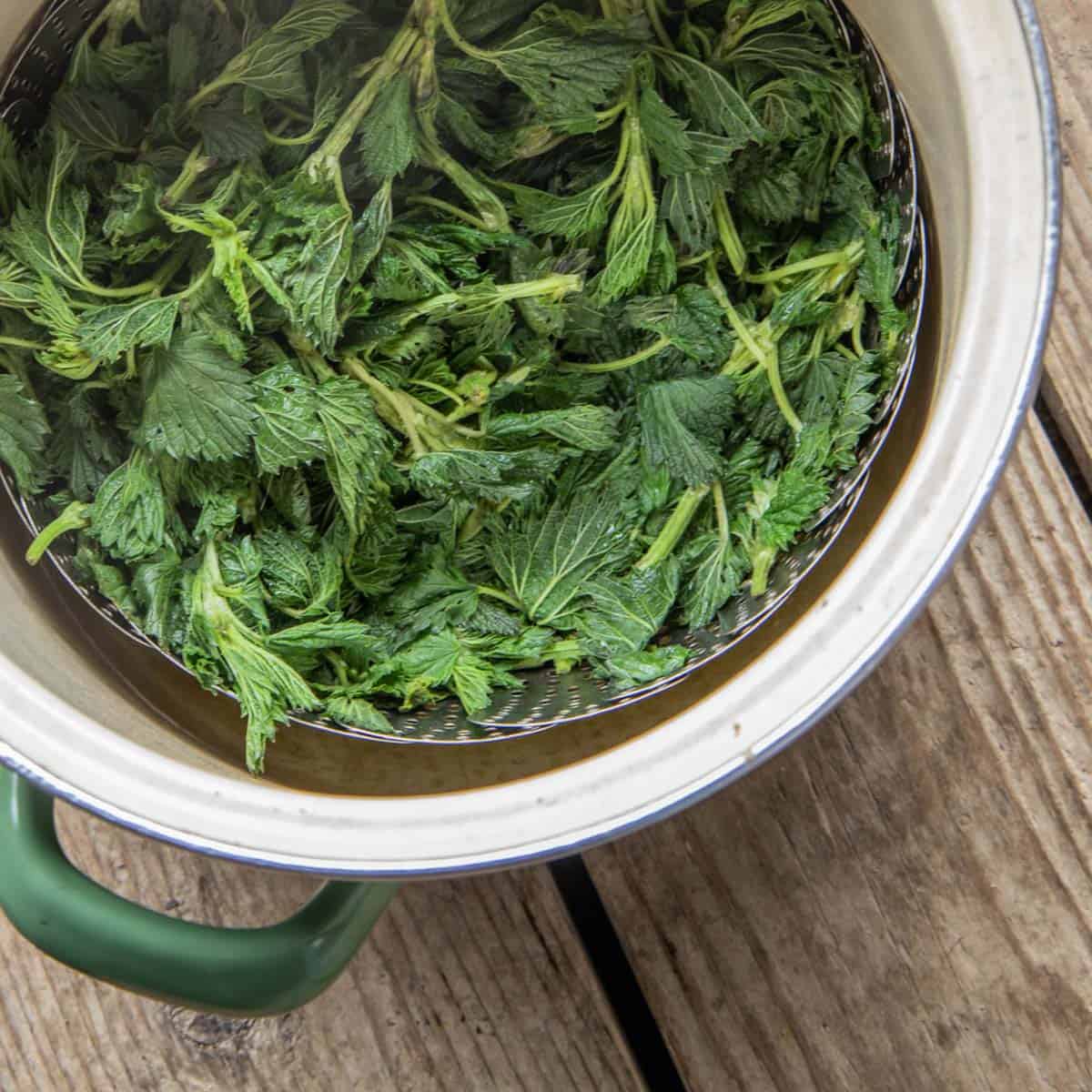
The other key is how it's thickened. I add boiled potatoes to the soup, instead of raw potatoes. Cooking potatoes in water before adding to the soup brings the flavor of the nettle to the front. It also removes some of the potato starch that can get overpowering and gummy tasting in pureed soups. Here's a walkthrough of how to make the soup.
How to Make Stinging Nettle Soup
First you steam your nettles, cool, chop ⅓ of them and reserve. To build the soup, you sweat a white mirepoix of celery, leeks and onions in butter. When the vegetables are tender, you add chicken stock and boiled potatoes.
After the soup comes to a simmer, you puree it in a blender with ⅔ of the nettles, add ing the cream and chopped nettles afterward. Finally, the soup is cooled in a metal bowl in a sink of cold water (if not served right away) and reheated gently to serve. The images below illustrate the process.
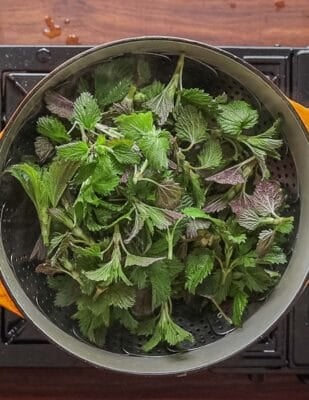
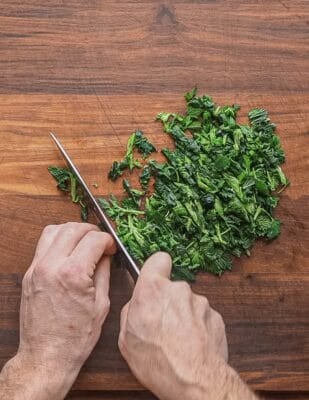
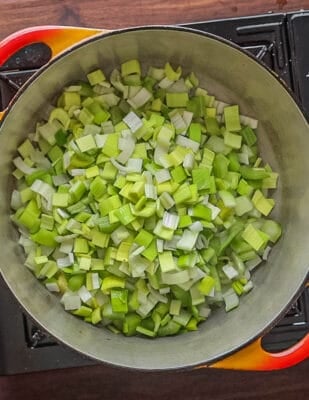
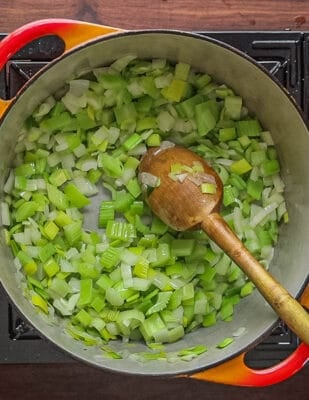
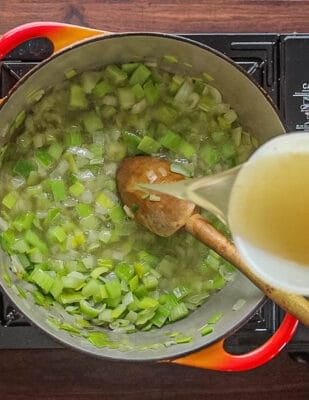
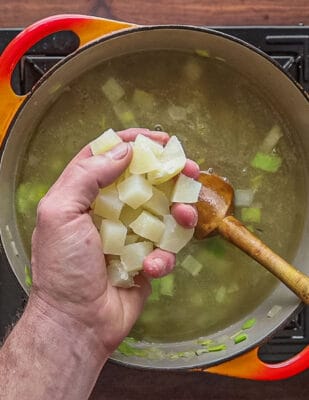
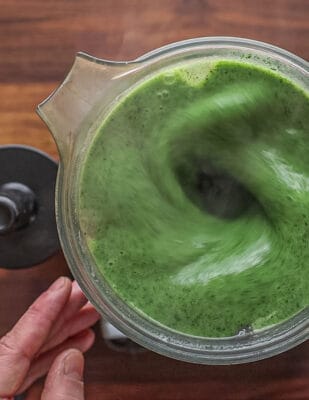
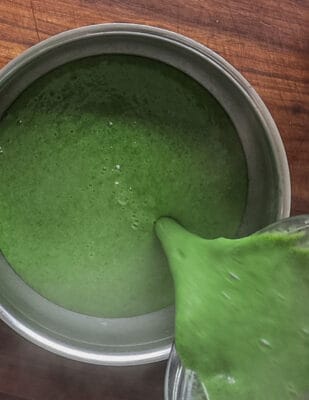
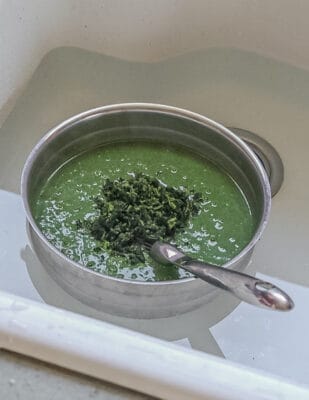

More nettle soup recipes
There's variations of this from around the world. Here's a few of my favorites:
- Isirgan Corbasi, with Mushrooms and Wild Onion Butter
- Sopa de Ortiga from Extramadura
- Zuppa Ortiche (Italian Nettle Soup)
Nettle Varieties
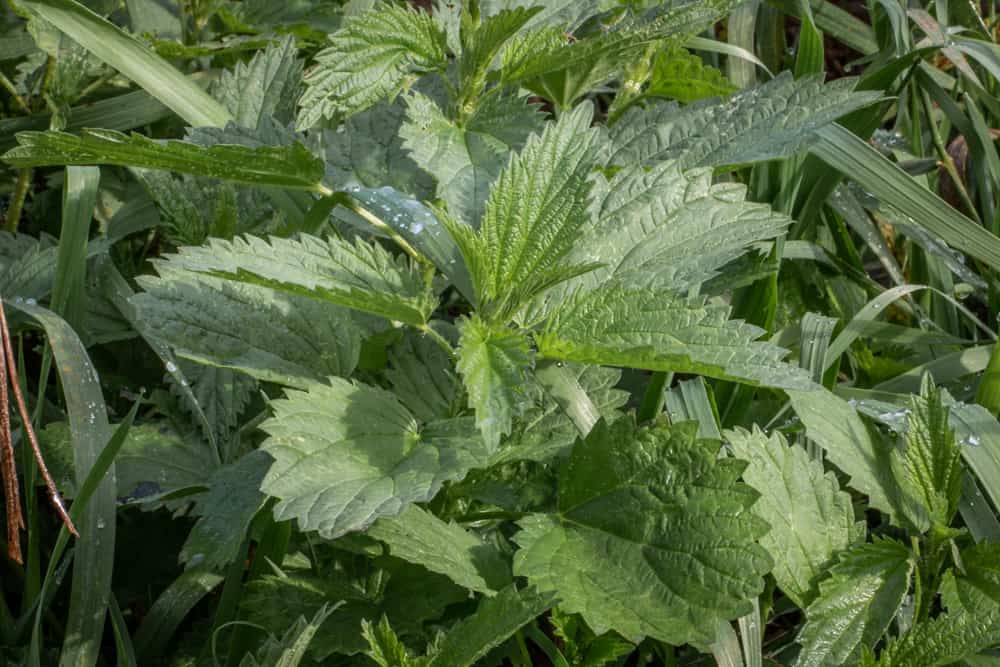
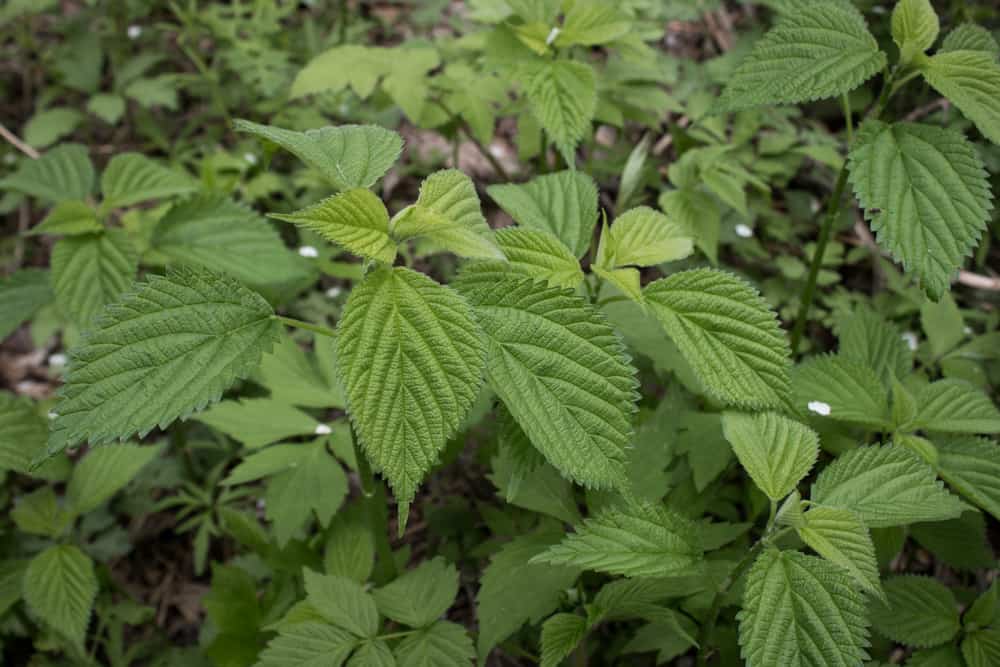
Classic Stinging Nettle Soup
Ingredients
Soup
- 4 cups chicken stock
- ½ cup heavy cream
- 2 cups diced peeled russet potato, roughly 1 large potato
- 2 cups diced leeks
- 2 medium sized shallots diced small
- 1 small yellow onion diced
- 3 tablespoons unsalted butter
- 1 cup diced celery
- Kosher salt to taste
- White pepper to taste
- 8 oz stinging nettles or roughly half a paper grocery bag full This should yield about 1 heaping packed cup after blanching, shocking and mincing.
Finishing and serving
- Crème fraiche
- chopped dill or mint
- chopped hard boiled egg optional
- extra virgin olive oil to garnish, optional
Instructions
Preparing the Nettles
- Harvest fresh nettles in the spring about 4-5 inches tall.
- Wash the nettles in a sink of cold water, then dry them.
- Working in batches in a large pot fitted with a steamer basket, steam the nettles until completely wilted. This should take about 2 minutes. Immerse the nettles in cold water. You can also add the nettles directly to the blender raw for a stronger flavor, just make sure to chill it quickly to preserve the flavor.
- Squeeze the nettles of excess water, chop finely and reserve. If you're more comfortable blanching nettles put 2-3 quarts of water in a large pot, along with 1 tablespoon of salt and bring to a boil, adding the nettles and cooking for 30 seconds, then shock in cold water and squeeze dry.
- Remove a handful of nettles and finely chop them to add after the soup is pureed.
Building the soup
- Sweat the celery, onion, shallot and leek on medium heat for 5 minutes. Add the chicken stock, potatoes, and bring the mixture to a simmer. Cook on medium-low until the vegetables are tender, about 15 minutes.
- Add the nettles and puree the soup a blender or with an immersion blender. Work in batches if you need. Pour the pureed soup into a pot (preferably metal as it cools faster). Chill in a sink of cold water or in a bowl with ice water.
- Add the rest of the finely chopped, reserved nettles back to the soup and stir in as a garnish if desired. Finally, whisk in the cream to loosen it. The flavor and color will improve as it sits.
Finishing
- Assess the consistency, if you prefer your soup more thin, add a splash of stock or water until it looks good to you.
- Double check the seasoning for salt and pepper, whisking to make sure the salt is completely dissolved before adding more. Serve, or transfer to a container and refrigerate for up to 3 days. The flavor will be at its peak if it's made the night before.
Serving
- Serve the soup ladles into warm bowls, garnished with spoonfuls of creme fraiche or olive oil, and any other garnishes.
Video
Notes
Nutrition
Common stinging nettles have a unique taste that's reminiscent of spinach and salt water, with a sort of oceanic flavor. Wood nettles have a rich perfume that reminds some people of apple blossoms.
Nettles are a nutrient dense plant rich in iron and other vitamins and minerals. Foraged plants are often "beyond organic" and raised without chemicals and pesticides.
No, cooking, dehydrating, or crushing nettles breaks the spines filled with formic acid and renders them harmless. After cooking they're no different from spinach.
Nettle soup freezes very well and is a great way to preserve nettles as they will be chewy and tough frozen without pureeing into a soup. The soup can also be made from frozen nettle.

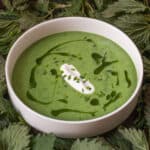
Sam
A great spring soup, hot or cold. I made it two weeks in a row and at it for both lunch and dinner. Thanks!
Alan Bergo
Thanks Sam
Gail Chase
Hi Alan,
Thanks for the recipe. I just discovered nettles on my property, and want to make your soup. I wonder why the water in which the nettles are cooked is discarded rather than used as part of the liquid for the soup. Is the water bitter, doesn it have bits of nettles in it, or is there another reason?
Thanks for your help!
Alan Bergo
Hi Gail. Blanching is one of the most traditional ways to denature the stinging trichomes on the plant that can irritate the skin. As I mention in the recipe instructions, the nettles can also be steamed, or added directly to the blender as they will cook in the soup from the residual heat/reheating after chilling, and the blender also breaks them down. There is a negligeable loss of nutrients from blanching and the flavor is still great. Some people might find non-blanched nettles too "fishy/strong tasting" especially if certain species of nettles are used that way, Urtica urens on the West Coast is said to be much more fishy than Urtica dioica, for example. The water is not bitter, and if you don't add salt the natural mucilage is a pretty well-known and documented natural hair conditioner. Hope that helps.
Martin
Nettles can be also used for chicken filling. This is what is being used for in Czechia (bacon, eggs, rolls, milk etc...) for Easter feast. 😉
Alan Bergo
Thanks Martin.
Martin
You're welcome. Can I ask as I'm just cooking this recipe is it supposed to be served cold or warm?
Thanks,
Martin
Alan Bergo
Hey Martin, I know the chilling after cooking part may seem confusing. It's served hot or cold, but typically hot. If it's hot outside I may thin it to a drinkable consistency and serve it chilled in a tea cup garnished with only oil, omitting the finely chopped nettles added at the end for texture. Chilling down the soup preserves the bright color, as well as the flavor. At nice restaurants, green soups like this are made ahead of time, with the green ingredients added only long enough to tenderize them so they can be pureed. The soup is chilled as fast as possible in ice water, then reheated to order for service just until hot, that way every bowl tastes fresh and bright green.
Shelley
This was delicious! I've never had nettles before in any form, so thanks for the recipe. I served it garnished with greek yogurt (no creme fraiche), a sliced hard boiled egg, and fresh dill. The egg made it a meal for us. 👍🏽😊
Alan Bergo
Thanks Shelley. Just made a gallon this week for a dinner. It was the favorite, again.
Margaret
Could you advise on how to freeze nettles? Do I need to steam them first? Chop or leave whole?
Alan Bergo
The easiest way is to blanch them in salted water until just wilted, about 45 seconds. Chill quickly in cold water, squeeze dry, vacuum seal. They can be steamed until just wilted too, but it can take a little longer to cook them and it’s easier to mess up their color. Just make sure to chill them quick after cooking.
Kristin
We served this at a "wild dinner" for a couple adventurous friends, and we all thought it was great! We tried it with different garnishes on top and particularly liked ramp oil or a little dollop of sour cream.
Alan Bergo
Glad you liked it. It's usually the very first thing I make when the nettles come out. My Dad (a conventional corn and soy farmer) even makes it now too.
Mike T
Delicious. Made 2 batches - added yesterday's left over Parsley sauce to one lot.... Added another flavour element and made it even better! 😋
Alan Bergo
Hey thanks Mike, glad you liked it. A little parsley or other mild herbs can be a nice touch.
Tara
But.... the quail eggs....
It looks like our nettle does have flowers. Would you suggest maybe not using them in this specific recipe? Lovely recipe, thank you.
Alan Bergo
Nettles that have flowers are beyond the stage of using as food. You can cut them down and it will make new growth though.
Martin
Well flowered ones can still be used for nettle tea. Which imo is great it has some natural sweetness. Just wash them, pour boiling water and let sit for couple of minutes (till it reach drinkable temp)
Tina Nelson
Can you use dried nettle leaves to make this soup ?
Alan Bergo
Hi Tina! Sorry I don’t recommend making it with dried nettles it just won’t be the same as fresh.
Alicia
My family was skeptical but everyone loved it. We have some new fall growth of nettle I used instead of spring time nettles. They can be a little tougher so this worked perfectly with them.
Ceejay Young
A friend of mine has a patch of nettle in her yard. I've raided that patch in previous years, but this year she kindly harvested for me. I've made this soup a number of times, and it is always amazingly delicious and fun to make. I garnished it with sour cream, violets and chives that have come up in our garden this spring. The bowl looked restaurant worthy and so tasty. Thanks, Alan, for this lovely soup recipe!
Alan Bergo
Thanks Ceejay. It's one of my all-time favorite soups.
Andrea
Remarkably delicious! I was thrilled to find nettles at my local market this morning, and even more thrilled with how this soup turned out. I don’t think I’ll ever want to cook nettles any other way. Thanks for sharing this prize recipe.
Alan Bergo
Hey thanks Andrea. If you really love the flavor of nettles you can also add them raw to the soup as it cooks, or puree them raw in the blender. The taste is so strong it's reminiscent of oysters.
Catherine Gilmour
Do you include all the stalks or just the leaves?
Alan Bergo
You will add the whole thing, assuming the stems are tender. The best nettles will be a few inches tall in the spring but the tops of the plants can be harvested in the early summer.
Gordon
Good recipe but a little too complicated. Why cook the nettles beforehand? Just add them at the tail of the sweat! No need to spread/squeeze/etc!
Alan Bergo
You can certainly do that, and if you read the recipe notes there's actually a method for that. You add the greens raw at the end of cooking, not the end of the sweat since it will denature the bright green color. You can also add the nettles to the blender at the end and they'll be cooked, then put the soup back on the stove, heat for a bit and adjust the flavor. Adding them raw gives a really rich flavor, almost oystery.
Seth Grube
Hello Alan,
As a forager, I just wanted to add that it's a good rule of thumb NOT to harvest the nettles after they've put out their flowers. There are studies that point to the silica level spiking in the plant after it flowers and this can cause kidney stones over an extended period if not harvested at the correct time. That said, Sam Thayer, arguably THE guru of wild plant harvesting for consumption, doesn't mention this caveat in his exhaustive Field Guide of Edible Wild Plants. He does say there is no concern with using older plants for tea. Hope this is insightful.
Alan Bergo
Hey Seth, yes, nettles harvested after they've flowered would be tough. I'd assume Sam doesn't mention that specifically since it's already assumed people will know that. If he did put that, he'd have to put a similar disclaimer on around 700 plants in the book, since it's kind of universal.
Judy
Just purchased some lovely nettles. I don't want to use dairy cream. Do you think the soup would work if I left it out or is there something else I could substitute for the cream? Thx
Alan Bergo
You can leave it out if you want. It won’t be quite the same, but it will be good.
patricia bangert
I make cashew cream for any soup requiring cream.
Mark
Lovely recipe. Thanks Alan. We did an A/B comparison with/without olive oil after an in-law, retired chef commented that serving it cold was a good idea. He felt that serving warm would “bring out some bitterness.” We both read that comment as a criticism.
Well, I much preferred the soup without the dash of olive oil. We’ve had a hard time finding an olive oil that doesn’t have some heat, and what “good” oil I tried detracted from the delicate flavor of the soup. Any suggestions for alternative oils? I’m thinking maybe pumpkinseed?
Alan Bergo
You can skip the oil and add a dollop of thinned sour cream. Olive oil as a garnish is traditional with Italian nettle soups, sour cream is traditional with Scandinavian versions. If you think olive oil is too strong pumpkinseed will definitely be too strong.
Sarah Werner
Hi Alan, could one reconstitute dried nettles to be used in this soup?
Alan Bergo
Potentially but you'll but on your own to find out the conversion ratio. I would use dried nettles rehydrated with just enough water to soften them equal to the weight of fresh nettles. Remember, 8 oz=1 cup.
Eikeen
Wish I had read this first. I used freeze dried nettles without doing your recommendation and I have very thick not smooth like I've had a French restaurants. Rh ks
Barb
I have nettles in my garden. I chopped them down a few months ago ( someone said it's a way to get a second harvest) and now they are regrowing. They look tender and I'm going to make the soup.
Alan Bergo
Thanks Barb. Let me know how you like it.
Steven Kang
Hi Alan, I made this soup yesterday and turned out excellent! My wife was quite impressed as well. I used a bit of almond milk instead of cream at the end because that's what I had, but it worked out. That pre-boiled potato method was a great trick. In the past, I tried your steamed nettle and nettle frittata which were excellent, but this soup is becoming one of my favourites as it motivates me to forage more nettles and freeze some for later in the year!
Alan Bergo
Hey thanks for commenting, I’m so glad it worked out for you. And yes, nettles get a little stringy when they’re frozen but that doesn’t matter puréed into soup, it’ll actually deepen the color.
Maureen P
Hello Alan! I just moved to Alaska! Although I was originally born in Minnesota and lived there until my early 30s. Then life took me all over the lower 48. But finally I have landed in Alaska. There is a vibrant community of foragers here and I am learning so much! I am beyond excited to try this recipe but have a few questions. First, can you use all frozen nettle while making it? I have some Minnesota friends coming to visit late August and would love to make this for them. Secondly, do you serve it chilled or do you reheat the next day before serving? While I am waiting for your reply I will clean all the spruce tips I harvested yesterday 🙂
Alan Bergo
Hi Maureen! The classic soup is served warm, however, I'm actually serving some cold this week. If I serve it cold, I sometimes add a small handful of fresh spearmint. It's lovely either way, but if you serve it cold, season it a little more than you normally would as chilling mutes flavors. A bonus of cold soups is that they can be garnished within an inch of their life with things that would wilt on a hot soup: think all the wild flowers, creative drizzles of creme fraiche or colored oils, etc etc. I'm here if you have any more questions, and good luck with the spruce tips.
Amy
Hey Alan. Thanks for sharing. I just managed to bring in a big haul of nettles out here in southeast Iowa. Maybe a silly question, but should I remove all the leaves from the stalks? I snipped the top of the stalk from each plant (2-3 sets of leaves), but it seems pretty thick and I'm not sure how much it will affect the flavor. Thanks in advance!
Alan Bergo
Hi Amy. No, not a silly question at all. There should never be a need to remove the leaves from the stems-use the whole thing. If the plant is older and tough it's too old to eat. I don't know where you're located so it's a little hard to me to know how old your nettles are. That said, even if you're nettles are a little older (the tender 2-3 inches of the plant can be harvested during the summer as long as it hasn't gone to seed, this recipe purees most of them and the rest are finely chopped, so it has built in safeguards against the greens being tough or chewy. I'm here if you have any more questions. You should also must try steamed nettles.
Amy
Thanks, Alan. I traveled just a bit outside of Iowa City, and I think I still have some time to harvest before they're too tough. You actually convinced me to go grab some more for the steamed nettles, which I'll absolutely be trying with the stinging nettle crepes! 🙂
Tina Harlin
Thank you Chef Alan. What a way to use fresh nettles! The soup came out so green and delicious! I will definitely be making it again in the spring.
Alan Bergo
Thanks Tina. It works really well with frozen nettles too.
Betsi Romero
I loved this recipe.
I bumped into this recipe after browsing the net to find a good use for a bunch of nettles I had been gifted. I happen to be vegan so I made a few modifications by replacing the chicken stock, heavy cream, and butter with Vegan "Not Chick'n" Bouillon, homemade cashew milk, and County Crock Plant-based butter.
I also garnished The soup with Plain Almond yoghurt, Dill and Olive oil!
A very lovely, comforting, and tasty way to incorporate such nutritious plant into our diets.
Alan Bergo
Glad you liked it! And yes, lots of ways you can substitute things here easily, thanks for sharing.
Marnie
I will try this recipe soon, when my nettles appear in spring here in Vermont. I also harvest them barehanded when younger, roll a leaf up like little Rugelachs and roll around in my palm and eat them for that bitter spring delight!
Karin
I love your website (and I love nettles)!
I'm a bit confused since the recipe above differ from that you have in your book. Which of them is the best due to your opinion?
Alan Bergo
Karin, either is fine. The recipe online here that instructed people to cook potatoes separately was a little overkill, so I changed it back to the original method where you cook the vegetables together. I'm super indecisive and change things all the time. Even writing down recipes gives me anxiety as, sans baking, I hardly ever make the same thing twice.
Karin
Thanks for your answer! I understand your concern, recipes (almost) never become ready, you change them continuously, if of no other reason just by curiosity.